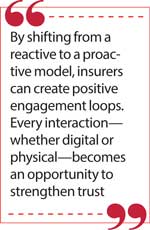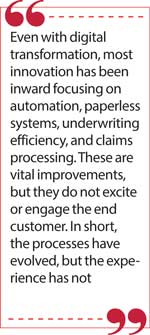Friday Nov 14, 2025
Friday Nov 14, 2025
Friday, 14 November 2025 00:18 - - {{hitsCtrl.values.hits}}

The era of transactional insurance is ending. The era of experiential, participatory, and rewarding insurance has begun
 For decades, insurance in Sri Lanka—and indeed much of the region—has remained a predictable business. From the way policies are sold to how customers are serviced, very little has truly evolved. Yes, the language of marketing has changed, call centres are more responsive, and digital portals now replace the dusty filing cabinets of yesteryear. But in essence, the model is still rooted in the same premise: pay your premium, stay covered, and hope you never have to claim.
For decades, insurance in Sri Lanka—and indeed much of the region—has remained a predictable business. From the way policies are sold to how customers are serviced, very little has truly evolved. Yes, the language of marketing has changed, call centres are more responsive, and digital portals now replace the dusty filing cabinets of yesteryear. But in essence, the model is still rooted in the same premise: pay your premium, stay covered, and hope you never have to claim.
The uncomfortable truth is that most customers rarely see tangible value from their insurance investment—except when calamity strikes. Until then, their relationship with the company is one of silent obligation rather than active engagement. The industry, for all its promise, continues to sell “protection” but not “participation”.
It is time the sector rethinks its purpose, its engagement model, and its social relevance.
A business frozen in tradition
Insurance, by its very nature, is a conservative business. It thrives on risk calculation, data integrity, actuarial prudence, and long-term guarantees. Those fundamentals must never change. Yet, this same adherence to caution has created a culture of inertia.
Most insurance providers still design products the same way they did a generation ago. A motor policy, a life policy, a medical cover, or a corporate plan – they differ only in packaging, not philosophy. The communications are predictable: “peace of mind”, “secure your family”, “protection for your loved ones”.
Even with digital transformation, most innovation has been inward focusing on automation, paperless systems, underwriting efficiency, and claims processing. These are vital improvements, but they do not excite or engage the end customer. In short, the processes have evolved, but the experience has not.
The customer’s dilemma
 Ask the average policyholder how often they think about their insurer. Chances are, they only do so when they renew their premium or file a claim. In other words, the relationship remains transactional, not emotional.
Ask the average policyholder how often they think about their insurer. Chances are, they only do so when they renew their premium or file a claim. In other words, the relationship remains transactional, not emotional.
To the customer, the annual payment often feels like a tax rather than a value-based investment. For motor insurance especially, many view it as a legal necessity rather than a personal benefit. Life and medical insurance policies, while essential, remain intangible promises—valuable only in moments of crisis.
So, for years—or sometimes decades—customers continue to pay, expecting nothing more than a receipt and a reminder. When the promise is not tested, there is no visible return. When the claim finally arrives, it is usually tied to stress, grief, or loss.
This emotional equation—pay now, benefit later if disaster strikes—is fundamentally flawed for the modern consumer. Today’s customer expects instant gratification, visible benefits, and year-round engagement. Insurance, sadly, has offered none of these.
The lost opportunity of engagement
What if insurance companies thought differently? What if they saw their policyholders not just as liabilities to be managed but as communities to be nurtured?
The logic is simple: if a customer stays loyal for years, continues to renew on time, and keeps their record clean, they should be treated as more than a number on a spreadsheet. Yet, few insurers have taken meaningful steps in this direction.
While banks, telecoms, and even supermarkets have built robust loyalty ecosystems, the insurance sector has largely remained passive. Engagement is often limited to holiday greetings, policy reminders, or automated birthday emails.
In contrast, customers today are hungry for recognition. They want to feel valued even when they do not make a claim. They want reasons to stay loyal beyond obligation. And that is where the gap—and the opportunity—lies.
The case for continuous value
In most industries, customer retention is driven by incentives. From frequent-flyer miles to supermarket loyalty points, consumers are trained to expect rewards for consistent behaviour. Insurance, with its predictable annual revenue base, is perfectly positioned to adopt a similar approach.
Imagine an ecosystem where policyholders enjoy year-round privileges—discounts on healthcare, wellness products, lifestyle brands, travel, dining, or even partner merchant offers—simply because they are part of the insurer’s family. Such engagement does not diminish the core service; instead, it enhances brand warmth and customer attachment.
One progressive insurer has already proven this concept in Sri Lanka. Through a well-structured loyalty and rewards program, it has redefined how insurance is perceived. Customers now receive ongoing benefits across multiple lifestyle categories, regardless of whether they make a claim. From supermarket shopping to leisure, fashion, and wellness, these everyday privileges have created a powerful emotional connection.
The result? Increased policy renewals, stronger retention rates, and a visible shift in customer sentiment. Policyholders are no longer silent payers; they are active participants who see real value throughout the year.
 Loyalty as a strategic tool
Loyalty as a strategic tool
Incorporating a loyalty component into insurance is not a marketing gimmick—it is a strategic necessity. It aligns perfectly with the industry’s long-term objectives: customer retention, brand differentiation, and sustained profitability.
From a financial perspective, the cost of acquiring a new customer is significantly higher than retaining an existing one. Loyalty and rewards help offset this challenge. By offering recurring privileges, insurers can build a buffer of goodwill that translates into advocacy and trust.
Moreover, such engagement generates rich behavioural data. Every redemption, every click, and every visit reveals preferences that can be translated into targeted offers and personalised experiences. For an industry increasingly dependent on analytics, loyalty programs offer a goldmine of insight—far more valuable than any third-party data set.
Breaking the myth of cost
Critics often argue that adding a rewards layer increases cost and reduces margins. In reality, modern loyalty ecosystems operate on partnerships and shared benefits.
Through collaborations with retailers, restaurants, travel partners, and healthcare providers, insurers can create win–win frameworks. Partners gain access to a high-value customer base, while the insurer enhances its service proposition without significant financial outlay.
Some innovative loyalty management platforms even automate these collaborations—tracking redemptions, validating claims, and analysing user patterns—without burdening the insurer’s core operations. The result is a seamless, tech-driven experience that rewards customers without administrative complexity.
Technology as the enabler
The digital infrastructure for such transformation already exists. QR-based cards, digital wallets, and mobile apps can now unify a customer’s entire engagement journey—from policy details and claim status to exclusive rewards and flash deals.
Through APIs and secure integrations, these systems can connect directly with merchant databases, ensuring real-time validation and instant gratification. The technology is scalable, secure, and cost-efficient. What is missing is the will to innovate.
Many insurers continue to see technology as a back-office tool rather than a front-end experience. Until that perception changes, the gap between service providers and their customers will only widen.
Reimagining the insurance relationship
The industry must embrace a new mindset—one that views insurance not merely as protection from risk, but as participation in life.
Customers should be encouraged to live better, not just prepare for the worst. Wellness incentives for non-smokers, rewards for safe driving, discounts for gym memberships, or points for preventive health check-ups—these are tangible ways to align insurance with lifestyle and wellbeing.
By shifting from a reactive to a proactive model, insurers can create positive engagement loops. Every interaction—whether digital or physical—becomes an opportunity to strengthen trust.
This is particularly relevant for younger demographics. Millennials and Gen Z consumers are not inspired by traditional policy brochures. They respond to experiences, not paperwork. A loyalty-driven model that offers lifestyle relevance will capture their attention far more effectively than actuarial promises.
A regional wake-up call
 Globally, insurers are already moving in this direction. Some European and Asian providers now offer reward points for healthy habits tracked through wearable devices. Others partner with retail chains to offer everyday savings. A few even integrate insurance with broader financial ecosystems—combining banking, investment, and lifestyle privileges into one seamless platform.
Globally, insurers are already moving in this direction. Some European and Asian providers now offer reward points for healthy habits tracked through wearable devices. Others partner with retail chains to offer everyday savings. A few even integrate insurance with broader financial ecosystems—combining banking, investment, and lifestyle privileges into one seamless platform.
Sri Lankan insurers cannot afford to lag behind. The competition will no longer come only from within the industry but from adjacent sectors that understand customer engagement better. If banks, telecom operators, and fintechs can create daily touchpoints, insurers too must build a living relationship with their customers.
The positive example
A leading Sri Lankan insurer has recently taken a bold step toward this new paradigm. Through its comprehensive loyalty program, it has broken away from the industry’s passive norm. The initiative offers its policyholders exclusive privileges across hundreds of partner merchants—from supermarkets and restaurants to wellness centres and fashion outlets.
The scheme is not restricted by policy type or value; benefits are available to all customers, regardless of their premium level. The program also includes seasonal offers, flash deals, and lifestyle tie-ups that add tangible value throughout the year.
The feedback from customers has been overwhelmingly positive. Many policyholders report feeling rewarded for their loyalty rather than forgotten after renewal. The brand, in turn, has strengthened its image as a customer-centric insurer that understands everyday life, not just emergencies.
This initiative demonstrates what is possible when a company dares to challenge convention. It has rewritten the narrative of insurance from a product of protection to a partnership of value.
The way forward
For the rest of the industry, the message is clear: the time for complacency is over.
Customers today compare experiences, not industries. They expect the same level of engagement from their insurer as they do from their favourite bank, airline, or online store. If the industry fails to meet this expectation, it risks irrelevance.
To move forward, insurers must:
These steps do not undermine the core principles of insurance. They enhance them. A customer who feels valued is more likely to remain loyal, more inclined to renew, and more willing to recommend.
Conclusion: From protection to partnership
Insurance is not just about paying claims; it is about keeping promises. Those promises must extend beyond crises into everyday life. The industry’s future depends on how well it can convert passive policyholders into active brand advocates.
The era of transactional insurance is ending. The era of experiential, participatory, and rewarding insurance has begun.
One visionary insurer has already lit the path forward. The rest must now follow—or risk being left behind in a world where customer loyalty cannot be taken for granted, only earned.
(The writer is the Founder and Chief executive Officer of CH17 Loyalty, the company in the forefront of emerging loyalty and rewards concepts. With more than a decade of experience in the rewards and loyalty sphere, he has developed game-changing strategies, innovative products that have added value to the services in finance & leasing and insurance sectors.)